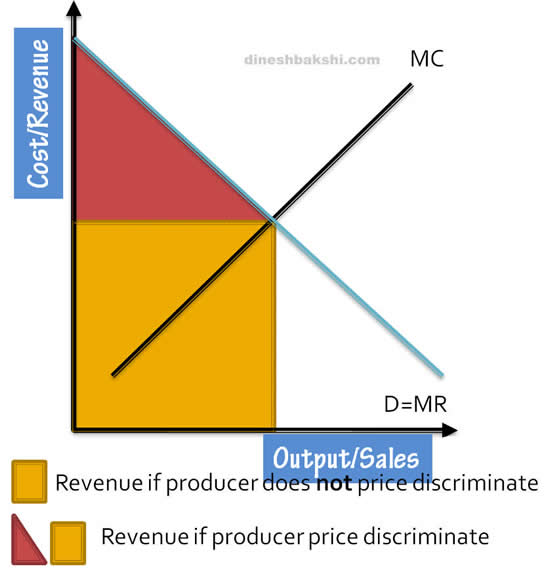What is Price Discrimination
Price discrimination or price differentiation exists when sales of identical goods or services are transacted at different prices from the same provider.
Price discrimination can only be a feature of monopolistic and oligopolistic markets, where market power can be exercised. Otherwise, the moment the seller tries to sell the same good at different prices, the buyer at the lower price can arbitrage by selling to the consumer buying at the higher price but with a tiny discount.
As long as a firm faces a downward-sloping demand curve and thus has some degree of monopoly power, it may be able to engage in price discrimination.
Conditions necessary for Price Discrimination
• The firm must have some degree of monopoly power—it must be a price setter.
• The market must be capable of being fairly easily segmented—separated so that customers with different elasticities of demand can be identified and treated differently.
• The various market segments must be isolated in some way from one another to prevent customers who are offered a lower price from selling to customers who are charged a higher price.
Examples of Price Discrimination
• Senior citizens and students are often offered discount fares on city buses and trains.
• Children receive discount prices for movie theater tickets and entrance fees at zoos and theme parks.
• Faculty and staff at colleges and universities might receive discounts at the campus bookstore/cafeteria.
• Physicians might charge wealthy patients more than poor ones.
Types of Price Discrimination
First Degree of Price Discrimination
In first degree price discrimination, price varies by customer's willingness or ability to pay. This arises from the fact that the value of goods is subjective. A customer with low price elasticity is less deterred by a higher price than a customer with high price elasticity of demand.

As you can see in the diagram, if the seller would not have used first-degree price discrimination, he would have a revenue represented by the yellow box. Seeing as though he was able to sell the shirts to customers at the price they were prepared to pay, more shirts were sold above market price, and he was able to eliminate the consumer surplus and gain additional total revenue(red triangle).
Second Degree of Price Discrimination
In second degree price discrimination, price varies according to quantity sold. Larger quantities are available at a lower unit price. This is particularly widespread in sales to industrial customers, where bulk buyers enjoy higher discounts.

As you can see in the diagram, the pricing of text messages by a cell phone company is shown. For the first 50 messages sent, $15 is charged, while any number of text messages sent over 50 is charge $10 for the next 50.
Suppliers do not know who is going to fall into which buying group (purchasing a lot of a little of a product) – force the buyers to self select into the pricing arrangement that is best for them.
Third Degree of Price Discrimination
In third degree price discrimination, price varies by attributes such as location or by customer segment, or in the most extreme case, by the individual customer's identity; where the attribute in question is used as a proxy for ability/willingness to pay.

In the diagram above the producer has segmented the market into A and B as per their relative elasticities. Market A shows the consumer group which as low PED while Market B shows the consumer group with high PED. The two MR curves added horizontally to give rise to the total market MR curve.
To maximise profit, the firm equates MR with MC and the point of intersection between the two determines the profit-maximising level of output Qt. The Output Qt has to be divided among Market A and Market B. The firm will now equate by charging higher price in markets with relatively inelatic demand (Market B) and lower price in market with relatively elastic demand (MarketA).
Thus we get in Market A, an output of Qa in at a price of Pa and in Market an output of Qb at a price of Pb.
Examples
• Airlines charge higher prices for business travellers than for leisure travellers.
• In India, there is a 50% discount of for senior citizens (aged above 60 years) on train journeys.
• Telephone companies may charge less during late nights.
Price Discrimination – An Evaluation
Advantages to the Firm
• Enables producers to gain a higher level of revenue
• Enables producers to produce more and gain from economies of scale.
• Profits gained in inelastic market segment can be used to drive away competition in more elastic market segment
Advantages to the Consumers
• Poorer consumers may be able to consume products.
• Allows people to purchase a product at a lower price than they would have had to pay if the producer had not been able to secure higher prices from others.
• Increased output provides opportunity for more consumers to use the product.
• Economies of scale: If total output increases significantly, this may result in lower average cost and thus lower prices for consumers.
Disadvantages of Price Discrimination
• Any consumer surplus that existed before the price discrimination will be lost.
• Some consumers will pay more than the price that would have been charged in a single, non discriminated market.
• If a firm succeeds in driving rival firms out from the market, it can use its increased monopoly power to increase prices and exploit the consumers.





